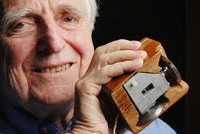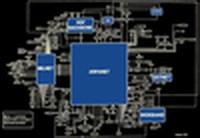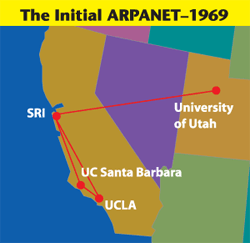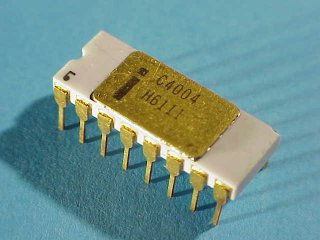The History of Computing through the ages
From 1960 - 1979
Four very memorable dates from our history of computing are 1963 - 1969 - 1971 - 1976. These particular dates hold a particular milestone in Computing History, as each one of them has changed the lives of everyone in our society today.
Thanks to Doug Engelbart 1963 was the turning point for all PC users today, as he invented the "x,y position indicator for a display system" now known as the mouse.
Then in 1969 the Birth of the World Wide Web sprung from a system known as ARPAnet.
Then the First Commercial Microprossesor was born in 1971.
And finally in 1976 Intel designed and produced the first microprocessor.
What can we expect next - OUR FUTURE will provide an insight in what we believe is coming our way very shorly, Please visit the links below for furthe information on these fascinating topics.





1963 - Douglas Carl Engelbart - 1925 - 2013
Inventor of the mouse
Doug Elgelbart grew up in the Pacific Northwest, during the early 1930s, Interestingly it is also where I spent the last 31 years of my life. From that small farm just outside Portland, Ore he would go on to invent the mouse as well as being given credit for co-inventing the hyperlink and the desktop interface as he said "it is all about adddressabiltiy - being able to find any given object in another given document" he was of course talking about creating and sharing documents.
Then came "The Demo - The mother of all demos"
On December 9, 1968, Douglas C. Engelbart and the group of 17 researchers working with him in the Augmentation Research Center at Stanford Research Institute in Menlo Park, CA, presented a 90-minute live public demonstration of the online system, NLS, they had been working on since 1962. The public presentation was a session of the Fall Joint Computer Conference held at the Convention Center in San Francisco, and it was attended by about 1,000 computer professionals. (Hunsinger Jeremy Luke, Timothy William, 2012 p.111)
 This was the public debut of the computer mouse. But the mouse was only one of many innovations demonstrated that day, including hypertext, object addressing and dynamic file linking, as well as shared-screen collaboration involving two persons at different sites communicating over a network with audio and video interface.
This was the public debut of the computer mouse. But the mouse was only one of many innovations demonstrated that day, including hypertext, object addressing and dynamic file linking, as well as shared-screen collaboration involving two persons at different sites communicating over a network with audio and video interface.
Many of those concepts are now part of our every day life, in part, because of Doug Engelbart's brilliance, and his openness in sharing what he was working on and inspiring so many. Engelbart's lab also helped develop ARPANet, the government research network that led to the Internet.
Douglas Engelbart shared these concepts with the world, and the world took them and built so many useful things with them. The computing world we live in today would likely be very, very different if there had never been a Doug Engelbart. (Hunsinger Jeremy Luke, Timothy William, 2012 p.111)1969 - What is the ARPAnet ?
And where did it begin
 The ARPAnet (Advanced Research Projects Agency Network) was one of the world's first operational packet switching networks, it was also the first network to implement TCP/IP and the progenitor of what was to become the global internet.
The ARPAnet (Advanced Research Projects Agency Network) was one of the world's first operational packet switching networks, it was also the first network to implement TCP/IP and the progenitor of what was to become the global internet.
Commercial activity on the internet has only been possible since 1969 when the ARPAnet was the domain of the US government research agencies. Business use of this was banned from the National Science Foundation's appropriate use policy.
The ARPAnet was developed at the peak of the cold war as an indestructible computer communications network. As the ARPAnet grew, other very similar networks were being developed with a more business side to them, even though they didn't have access to the ARPAnet. The ARPAnet lead to the development of the world wide web, which was developed by CERN in Switzerland, the world wide web was the fastest growing section of the internet, this was based on the Hypertext mark-up language, this was used to create webpages which can be easily navigated by using multiple hypertext links.
From this came browsers, the first developed was Mosaic, of which 2.5million copies were downloaded within the first year of its release, 20000 copies are still being downloaded every month, from this bigger and better browsers were being developed which could run faster and respond better to the different websites.
1971 - Intel 4004
And how it has developed
 The Intel 4004 is a CPU (or Central Processing Unit) that is widely regarded as the first mass-produced single-chip microprocessor available for public use. Introduced to the public in 1971, its existence and very presence within the computing world was a revelation at the time of its production, as it combined the main elements that were vital to the brain-power of the computer itself by compressing it into a single microprocessor chip. The chip did the thinking job for the computer, and it calculated all of the variables the PC needed in order to logically deduce things - and it was the size of a fingernail.
The Intel 4004 is a CPU (or Central Processing Unit) that is widely regarded as the first mass-produced single-chip microprocessor available for public use. Introduced to the public in 1971, its existence and very presence within the computing world was a revelation at the time of its production, as it combined the main elements that were vital to the brain-power of the computer itself by compressing it into a single microprocessor chip. The chip did the thinking job for the computer, and it calculated all of the variables the PC needed in order to logically deduce things - and it was the size of a fingernail.
In fact, the overall basic design of the chip itself is used as a baseline and a staging ground for modern day microprocessors, making the Intel 4004 the ancestor of nearly every microprocessor chip out there, with others based on similar design elements. Without this invention, modern day computers could easily be very different to what they are presently.
Essentially, the invention of the Intel 4004 was one of the most defining moments for modern day computers, simply because of its revelatory design of being so small, yet so powerful for the time.
1976 - History of Apple Computer, Inc And how it has developed
 In April 1976 Apple Computer, Inc. was founded by Steve Wozniak, 26, and Steve Jobs, 21 to sell Wozniak's hand-made personal computer, the Apple 1. The Apple 1 was sold as a kit; in the kit was a circuit board with a manual. Anyone lucky enough to have bought one had to provide their own case, power supply, keyboard and monitor. In 1984 the Macintosh computer was released. It is considered to be the first computer to feature a multi panel window Graphical User Interface, except for Apple Lisa which was released in 1983.
In April 1976 Apple Computer, Inc. was founded by Steve Wozniak, 26, and Steve Jobs, 21 to sell Wozniak's hand-made personal computer, the Apple 1. The Apple 1 was sold as a kit; in the kit was a circuit board with a manual. Anyone lucky enough to have bought one had to provide their own case, power supply, keyboard and monitor. In 1984 the Macintosh computer was released. It is considered to be the first computer to feature a multi panel window Graphical User Interface, except for Apple Lisa which was released in 1983.
Our Future - A Brief Summary Of Nano Technology
And how it has developed
 Many people don't realise that Nano Technology has been here on this wonderful planet of ours since time began. We as humans are only just discovering the wonders of Nano Technology and what benefits we can create by adopting this technology for our use.
Many people don't realise that Nano Technology has been here on this wonderful planet of ours since time began. We as humans are only just discovering the wonders of Nano Technology and what benefits we can create by adopting this technology for our use.
An example of this is Ants. We all know what ants are, we have all probably have seen various types and some of us probably find them irritating. But look at them in a different way and you will find Nano Technology in its purist form.
Most ants are 1 to 5 mm in length, have thousands of nano and microbioscale subsystems and devices which have evolved and advanced over millions of years. These ant systems are extremely small, efficient and robust. Another quick example is the well-known Escherichia coli (E.Coli) bacterium which is 1000 times smaller than an ant and the length of the Bacteria is 2um. Although this is a single cell bacteria, E.Coli has nanoscale subsystems and devices, such as nanobiomotor, which is 45 nm in diameter, is built using different proteins, many of these proteins form nanobiocircuits and nanosensors.
This and various other bacteria have several identical nanobiosubsystems, devices and structures such as nanobiomotors, flagella and nanobiocircuitry.

You can even scale this down further to find different biological systems and devices. If you research the protein, molecular and atomic levels you will find the sizing attributes can be very different in size and a whole new measuring capability has been devised. This sizing technique has been used to greatly enhance our capabilities in understanding Nao Technology Structures. By using this Technology we can adapt this structure into creating Nano Technology within almost anything we create and for us within the computer industry it could mean much smaller systems which will be more reliable, robust, faster and more efficient.
References Quotes and Citations Here you can find our references to our work
1963 - Doug Engelbart
Hunsinger, Jeremy (Editor) Luke, Timothy William (Editor), Putting Knowledge to Work and Letting Information Play (2nd edition), Rotterdam, DEU: Sense Publishers, 2012, p111.
Acknowledgements to pictures on Doug Engelbart
By Michael Liedtke, Associated Press Posted on July 5, 2013 at 9:29 PM
www.wvec.com
Acknowledgements to posters for Doug Engelbart
Brittany Hillen, Last Updated Jul 3rd 2013
www.slashgear.com
1969 - The ARPAnet
International Journal of Information Management volume 16, pp. P1, 83-102, 1996, Printed in Great Britain
Acknowledgements to pictures on The ARPAnet
image provided by Craig Partridge
www.personalpages.manchester.ac.uk
Acknowledgements to posters for The ARPAnet.
bradleyhardin.com
The History Of The Internet
1971 - Intel 4004
published by www.fundinguniverse.com, last updated 1st april 2013
Acknowledgements to pictures on Intel 4004
James Grahame on November 15, 2011
www.retrothing.com
Photos Courtesy of Steve Emery
www.computermuseum.li
Acknowledgements to posters for Intel 4004
James Grahame on November 15, 2011
www.retrothing.com
1976 - Apple Inc
Hamza, K.A. (1988), "Vision Systems", in Jones, P.J., Smith, R. & Watson, E.P. (eds), Artificial Intelligence Reconsidered (2nd edition), New York: Wiley, pp. 12-34
Acknowledgements to pictures on Apple Inc.
www.fundinguniverse.com
Acknowledgements to posters for Apple Inc.
by Amy Willis
www.wallsave.com
www.wallsave.com
Acknowledgements to websites for Apple Inc.
www.fundinguniverse.com
www.oldcomputers.net
www.oldcomputers.net
www.vectronicsappleworld.com
Our Future - A Brief Summary Of Nano Technology
Sergey Edward Lyshevski, Published 2005, Nano-and Micro-Electromechanical Systems 2nd Edn Published in Boca Raton, London, New York and Washington DC, by CRC Press, P1.
Acknowledgements to pictures on Nano Technology.
Katrien Marent, Director of External Communications IMEC
www2.imec.be
Acknowledgements to posters for Nano Technology.
APA Citation - North Central, by Charles Yost - Last Updated Sep 12, 2013
www.libguides.ivytech.edu
Dr. Claudia Aguirre
www.dermalinstitute.com
Ulla Holm Vincentsen, project manager
www.tekno.dk
Rui Natario
www.networksandservers.blogspot.co.uk
Mike Campbell
www.earthtimes.org
Money For Your Phone, Posted March 23, 2012
www.moneyforyourphone.com
Nano Phosphate Lithium Ion Technology
www.toolmonger.com